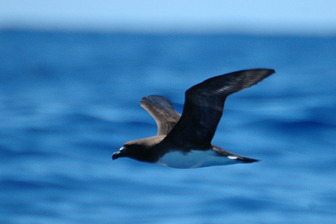Tahiti Petrel

Original source: Original uploader was Aviceda at en.wikipedia(Original text : Tom (talk))Permission(Reusing this file)CC-BY-3.0.
Author: Original uploader was Aviceda at en.wikipedia(Original text : Tom (talk))Permission(Reusing this file)CC-BY-3.0.
The Tahiti Petrel is classified as Near Threatened (NT), is close to qualifying for or is likely to qualify for a threatened category in the near future.
* Tahiti Petrel Pterodroma rostrata Adult in flight New Caledonia (ssp trouessarti) Alan Tate 1 March 2007 22 weeks ago 3 Sounds 0 recordings * No sound recordings available yet * Send or share this page * Email this pageEmail this page About us | Contact us | FAQ Advertising more » More
The largest member of its genus, the Tahiti petrel is a dark brown seabird, with slightly paler uppertail-coverts, and white underparts which are clearly demarcated from the brown upper chest. The central part of the dark underwing bears a thin, pale ... More
The largest member of its genus (4), the Tahiti petrel is a dark brown seabird, with slightly paler uppertail-coverts, and white underparts which are clearly demarcated from the brown upper chest (3) (5). The central part of the dark underwing bears a thin, pale stripe (2) (3). The beak is black and particularly robust, and, like other petrels, bears characteristic tubular nostrils (3) (6). The male and female are similar in appearance (3), and the juvenile Tahiti petrel resembles the adult (2). More
directly compared with the Tahiti Petrel; and, (iii) identification was strongly based upon the pale throat a characteristic that is now thought to be invalid. Click here to see the most recent evidence which finally confirms the rediscovery of this enigmatic bird... More
Tahiti Petrel, N of New Caledonia, April 2007 North of New Caledonia, April 2007 (see also photo of underwing) © A. R. More
looking at the Beck More
41 cm, 400 g the Tahiti petrel build his nest in the mountains of Tahiti, Moorea, the Leeward islands, the Marquesas and the Gambier, more than 150 m high, often far from the sea. It lays a single egg in its burrow, established under tree roots or rocks, visited only at night. Silent at sea, the Tahiti petrel whistles strongly near the nests. Photo : Philippe Raust Phoenix Petrel, Pterodroma alba, Putuputu (Pitcairn). 35 cm, 270 to 280 g. More
50+ Tahiti Petrels, one Collared Petrel on the first day and 30+ Tahiti Petrels on the second - on our return to the quay at dusk we had a gathering of an additional 50+ Tahiti Petrels, waiting to return to their breeding burrows ashore. Supplementary species seen during sailings were many Red-footed Boobies and Crested Terns, flocks of both Brown and Black Noddies, Lesser Frigatebirds, a couple of Black-naped Terns and a lone Bridled Tern. More
Tahiti petrel, a member of the Albatross family, nests on the ground as well as the Murphy Petrel. There are several varieties of stern including the Great-crested Stern and the White Stern. Interestingly, the White Stern doesn't build nests: its egg and chick have to keep on the branch by themselves. Several varieties of pigeons are also to be found on Tahiti, among them the very large Carpophage (about 50 cm) from Nuku Hiva, Marquesas. More
Family : Procellariidae
Genus : Pseudobulweria
Species : rostrata
Authority : (Peale, 1848)

